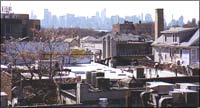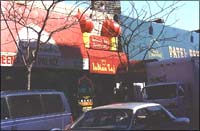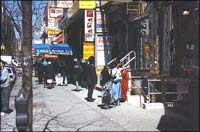The Rediff US Special/Arun Kristian Das
Saris and Spices: The Changing
Face of New York
Recently, Nitin Vora took an order on telephone from Unni Krishnan for a VCR.
Vora filled out the invoice and had the VCR taken out of stock and packed for pickup by UPS.
 From Jackson Heights, New York, the package wound its way across the United States and over the Pacific to reach its destination: Krishnan's house in Honolulu, Hawaii.
From Jackson Heights, New York, the package wound its way across the United States and over the Pacific to reach its destination: Krishnan's house in Honolulu, Hawaii.
Honolulu has no shortage of VCRs. Still, Krishnan ordered his device from Sam and Raj, an electronics store in the heart of the internationally renowned strip of Indian shops on 74th Street in Queens.
"Sam and Raj was this neighbourhood's first Indian store," says Vora, 51, manager of the store, which was established in 1973. "Now, 28 years later, there are more than 200 Indian businesses in a two-block area."
Vora, originally from Bombay, has watched Jackson Heights transform from a quiet, mostly residential area of two- and three-storey row houses into a teeming commercial hub. It is frequented by Indians and other South Asians from all over the Tri-State area, and, according to Vora, from as far as Maryland.
According to the 2000 US census released on May 21, the Asian Indian population in New York City grew by 81 per cent in the last 10 years -- from 94,590 to 170,899.
This growth rate is way ahead of the other Asian communities in New York City, where Asian Indians now constitute the second largest Asian group, after the Chinese.
In New York State, the Asian Indian population increased by 79 per cent in the past ten years -- from 140,985 to 251,724.
The largest increase took place in the Manhattan and Queens boroughs -- 98 and 93 per cent, respectively. Numerically the greatest numbers of Asian Indians live in Queens -- 109,114, up from 56,601 in 1990.
In fact, the growth rates for Asian Indians dwarf New York City's overall population growth rate. Although the city's population topped eight million for the first time (8,008,278), that is just a 9 per cent increase since 1990.
Among the many Asians who came to New York, and Queens, in the 1990s were droves of South Asians, settling in the growing neighbourhoods of Jackson Heights, Elmhurst and Richmond Hill, among others.
The growth of a certain race can also be measured by looking at the proliferation of its spiritual base. Dr Uma Mysorekar, president of the Hindu Temple Society of North America based in Flushing, Queens, is thus another observer of how fast the city has changed over the years.
 A physician, Dr Mysorekar has lived in New York for 33 years and seen first-hand the extremely rapid proliferation of Hindu temples in America. While 20 years ago just a few hundred faithful would gather in houses of worship, today, she says, thousands gather at 6 o'clock in the morning waiting for the temple doors to open.
A physician, Dr Mysorekar has lived in New York for 33 years and seen first-hand the extremely rapid proliferation of Hindu temples in America. While 20 years ago just a few hundred faithful would gather in houses of worship, today, she says, thousands gather at 6 o'clock in the morning waiting for the temple doors to open.
"Whether they are coming here for solace or to give thanks to God," says the Bangalore native, "Hindus make the time to gather for their spirituality."
She estimates that temple-goers have increased by 40 to 50 per cent over the last 10 years -- uncannily close to the 54 per cent citywide increase in Asians as reported by the census.
The businesses on 74th Street, which cater to Indians, Pakistanis and Bangladeshis, include numerous restaurants serving $5.95 buffet lunches (including the famous Jackson Diner), Mita Jewelers, Patel Brothers supermarket [selling such products as whole and crushed chili, masoor dal and moong dal and even 50-pound bags of basmati rice -- all imported from India] and Vijay Video, which displays an impressive catalogue of Hindi films on videotape and DVD such as Dil to Pagal Hai and Kuch Kuch Hota Hai.
A mecca of Indian culture could not be complete without stores offering fabrics and clothing of vibrant colours. In the 1980s, sari stores were very popular, with more than two dozen lining 74th Street. But the demand for saris has fallen, and only a handful of stores remain, says Vora, because few Indian women wear saris daily. Many women, especially the younger generation, prefer Western clothes, while others prefer more casual Indian attire.
Jewellery stores, on the other hand, have proliferated as Indian families in America have prospered. Jewellery "has an ethnic value", says Vora. "Gold is both for beauty and is an investment."
 Despite the concentration of Indian culture in Jackson Heights, the actual South Asian population in Queens is generously spread out. Indeed, Jackson Heights itself is not necessarily where most of the 74th Street shops' patrons live.
Despite the concentration of Indian culture in Jackson Heights, the actual South Asian population in Queens is generously spread out. Indeed, Jackson Heights itself is not necessarily where most of the 74th Street shops' patrons live.
"Historically, the [Indian] populations have lived in Elmhurst, because Jackson Heights was always meant to be more expensive," says Frank Vardy, a senior demographer with the New York City planning department. "For whatever reason the Indian businesses took up on 74th Street, often those who own and those who frequent those businesses come from the surrounding communities."
So the Indian businesses naturally find themselves thriving in someone else's figurative backyard, and, as with any growing urban community, residents clash.
According to Ramesh Navani, 57, an ownership partner of India Sari Palace on 74th Street and president of the Jackson Heights Merchants Association, many, if not most, landlords in Jackson Heights are white, and many of the residents of nearby co-operatives and row houses are also people of European descent.
As with most other New York neighbourhoods, Jackson Heights and nearby Elmhurst have seen a steady influx of Korean, Chinese and Latin American immigrants, along with related businesses, but the Indian stores on the strip, Navani says, seem to bear the brunt of community anger.
"Within the neighbourhood, there can be a clash of cultures," he says. "They have a certain way, and we have a certain way, so there is uneasiness. That uneasiness sometimes erupts into conflicts."
 When Navani, who came to New York from New Delhi in 1971, opened his sari store across the street from Sam and Raj in 1976, it was the neighbourhood's second Indian store, he remembers.
When Navani, who came to New York from New Delhi in 1971, opened his sari store across the street from Sam and Raj in 1976, it was the neighbourhood's second Indian store, he remembers.
"When many Indian immigrants started to come to New York City in the 1970s, their resources were limited," he says. "We looked for an area that is convenient and not too expensive to live in. One that is easily accessible to the subway and to Manhattan, somewhere it isn't too hard to secure a home and find work."
Jackson Heights lies right along the Number 7 subway line, which provides direct access to midtown Manhattan in about 20 minutes. "When the people begin to locate themselves in one area, the service industries follow," says Navani.
"It was a completely different neighbourhood," concurs Lucy Blaniewski, who came from Poland to Jackson Heights 28 years ago. "It was clean, now it is dirty."
Blaniewski, a senior citizen who has watched the steady influx of immigrants, like herself, set down roots in the environs of 74th Street, says she hears Spanish spoken on the streets and sees "saris, saris, saris" everywhere.
"I have nothing against them," she says. "But the streets are dirty, full of paper, they should do something."
"There is a feeling that we are not keeping the neighbourhood clean, that we are creating traffic congestion, noise pollution -- these are common complaints," agrees Navani. "To some degree, I'd agree that maybe we do lack some common civic sense. It's been brought to our attention, and we must try and do our part to do better."
But while accepting a share of responsibility in the neighbourhood's much-needed upkeep, Navani makes a plea to the city to react to a community that is bursting at the seams. "We cannot ignore the fact that the community has grown, business has grown, but the city services have not grown in proportion," he says.
 After all, the Indian businesses generate hundreds of thousands of dollars in tax revenues, and it is only right that government puts some of that money back into the community, he feels.
After all, the Indian businesses generate hundreds of thousands of dollars in tax revenues, and it is only right that government puts some of that money back into the community, he feels.
It seems that complaining about city services is a common pastime for New Yorkers, as an ever-growing population puts a strain on infrastructure and services. This also leads to the overcrowding of public schools in urban areas.
"The schools are really busting, they're really overcrowded," says Joan Barnett, a 24-year resident of Jackson Heights who works at Public School 148 in East Elmhurst.
But Barnett is one of many residents who also acknowledges the good with the bad. The neighbourhood "is prosperous, in that way it's good, real estate is good", she says. "I don't worry about walking the street at night. At 10 o'clock, 11 o'clock there's always people on the street and that's a good thing. I come home on the subway at that time of night and there's always people -- you can't even get a seat -- which is good to me."
The city's prosperity, echoed in these smaller neighbourhoods, has undoubtedly resulted in rapid and vast change. And the success of Indian entrepreneurs naturally invites the arrival of more people seeking such opportunities, and the communities grow even faster.
While the feeling of safety in numbers may be a comfort to Barnett, she can't deny that the narrow streets of her neighbourhood are too jam-packed with automobiles and delivery trucks. The traffic really gets to her. "Parking and driving is horrendous," she says. "People double-park constantly, and that's the biggest problem."
"Wherever you go in New York City, where is there not a traffic problem?" counters Navani. "I understand their point of view because this was once a peaceful neighbourhood 25 years ago with few shops. Now it's an international market known around the world."
(Aseem Chhabra contributed to this story.)
Also see:
Asian Indian Population Doubles In a Decade
Back to top
Tell us what you think of this feature